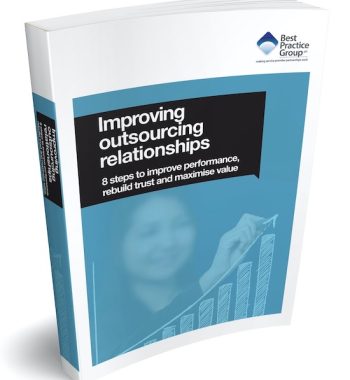 In the pursuit of successful strategic supplier relationships, the old adage ‘prevention is the best cure’ comes to mind frequently, so the question of how to minimise and mitigate procurement risk is a common one. The fact is that most faulty or failing supplier relationships are the result of a poorly executed procurement and contracting process. A poorly constructed contract will inevitably lead to miscommunication between both the client and the vendor, which is likely to result in dissatisfaction further down the line. This article highlights the four main steps for a risk-free procurement strategy (supported by our Optimise methodology) that will ensure a successful strategic supplier relationship.
In the pursuit of successful strategic supplier relationships, the old adage ‘prevention is the best cure’ comes to mind frequently, so the question of how to minimise and mitigate procurement risk is a common one. The fact is that most faulty or failing supplier relationships are the result of a poorly executed procurement and contracting process. A poorly constructed contract will inevitably lead to miscommunication between both the client and the vendor, which is likely to result in dissatisfaction further down the line. This article highlights the four main steps for a risk-free procurement strategy (supported by our Optimise methodology) that will ensure a successful strategic supplier relationship.
The BPG Optimise methodology for quality-assured procurement, implementation and contract management, minimises risk by ensuring that procurements result in contracts that benefit both parties and leave no room for confusion, and fit-for-purpose solutions that are implemented on time and on budget.
4-Step Procurement Strategy to Mitigate Procurement Risk
Step 1: Know and Define Your Requirements
The first thing you must do is gather your requirements and create your requirements documentation. This should be done in such a way that the document is aligned to business outcomes, but which does not prescribe how the supplier is to fabricate or deliver the solution.
The requirements gathering process should be entered into by all stakeholders and relevant team members to ensure that all requirements for the future service/solution have been captured and agreed. Once you have this information to hand it must be translated into an output-based specification that also includes a description of the key ‘as-is’ business elements and any factors or changing parameters that influence relevant operations.
Step 2: Provide a Template for Tenders
When it comes to comparing tenders, it is vital that you are able to make a like-for-like comparison. This is only possible if you provide a fixed template as to how the tenders should be laid out from one contractor to the next. You should also stipulate in express terms how you intend the entire procurement process (through to contract execution) to run. Your documentation should clearly set out the overall procurement process and each vendor must sign off that same written process in order to confirm their agreement to it. This is an important step in protecting your interests against potential future challenges or claims. It is often a good idea (but not essential) for your full proposal template to reflect the layout of the contract, given that one will invariably lead into the other, and clarity of layout and navigation will make managing the contract that much easier in the future.
Step 3: Create and Execute an Evaluation Framework
Before issuing your requirements documentation you will need to formulate a process for evaluating tenders in a manner that is as objective and auditable as possible. To do this you must agree two things:
- What your evaluation criteria are
- How each criterion will be weighted
On a broad scale this might be 30% for price (commercial response) and 70% for quality (technical response presenting the solution or service), but you will want your scoring to be more in-depth than that. Examples of items you might consider are:
- Robustness of the implementation plan
- Fitness for purpose of the solution without customisation
- Quality of any interface designs
- Risk factors attached to the proposed service/solution.
There are various criteria that might be relevant to any given solution — you need to boil them down into an appropriate evaluation matrix. It is fundamentally important that the method for carrying out the evaluation is transparent, auditable and absolutely clear to all parties (both in the present and in the future). The evaluation framework you design should (must if in the public sector) be included when you issue your procurement documentation.
Step 4: Provide for Pre-Contractual Supplier Due Diligence
This may be the last major step, but it is by no means one to be neglected. It is in fact the lynchpin to the successful implementation of a contract and forms the cornerstone of our Optimise procurement methodology. The concept is simple — you must recognise your vendor as an ‘expert supplier’ and contract with them for expert advice in the pre-contract stage (if, in the public sector, your procurement process allows this). If this is not possible then you must make the execution of the contract contingent upon successful expert due diligence. The thinking behind this is threefold:
- By contracting with your provider as an expert you are far better protected from any future contractual issues
- Going through this process ensures that there is a deep dialogue between client and vendor before the client has to commit
- By expressly binding the vendor’s expert advice into the contract of supply, you gain enormous protection in the event that the vendor fails to perform the contract properly.
Hard Work Up Front to Mitigate Procurement Risk Reaps Benefits Down the Line
The above proposed approach to mitigate procurement risk is a broad indication of our recommended Optimise methodology, rather than an in-depth guide. While it does involve a lot of work, we recommend it because we know that the time invested in the pre-contract stage will result in a much smoother and more effective contract management process and a far better chance of the contract achieving all of your required outcomes. Additionally, the above process effectively builds in a contractual ‘insurance policy’ should you need to rely upon it in the future. The overriding principles here are ones of absolute clarity, visibility and understanding — both vendor and client should be in absolutely no doubt of what is expected from them and the contract. The best case scenario under such circumstances is that the contract runs smoothly, but if the worst should happen, the client is well protected by an ironclad agreement that was preceded by a solid procurement process.

